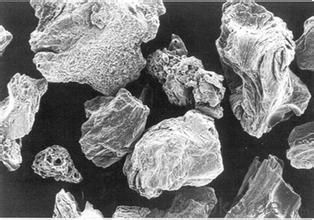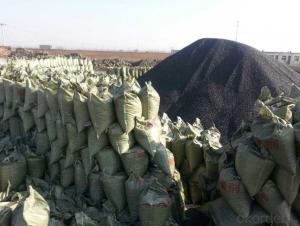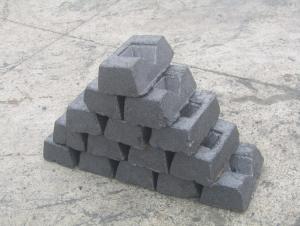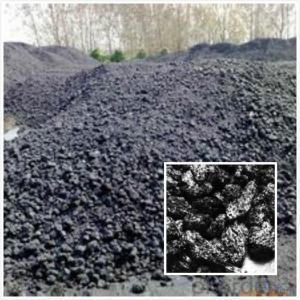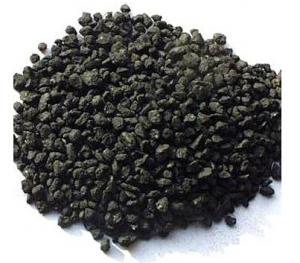Low Ash and Low Sulphur Calcined Petroleum Coke
- Loading Port:
- Tianjin
- Payment Terms:
- TT OR LC
- Min Order Qty:
- 1 m.t.
- Supply Capability:
- 10000000 m.t./month
OKorder Service Pledge
OKorder Financial Service
You Might Also Like
1.Structure of Calcined Petroleum Coke Description
Calcined Petroleum Coke is made from raw petroleum coke,which is calcined in furnace at a high temperature(1200-1300℃).CPC/Calcined Petroleum Coke is widely used in steelmaking,castings manufacture and other metallurgical industry as a kind of recarburizer because of its high fixed carbon content,low sulfur content and high absorb rate.Besides,it is also a best kind of raw materials for producing artifical graphite(GPC/Graphitized Petroleum Coke) under the graphitizing temperature(2800℃).
2.Main Features of the Calcined Petroleum Coke
High-purity graphitized petroleum coke is made from high quality petroleum coke under a temperature of 2,500-3,500°C. As a high-purity carbon material, it has characteristics of high fixed carbon content, low sulfur, low ash, low porosity etc.It can be used as carbon raiser (Recarburizer) to produce high quality steel,cast iron and alloy.It can also be used in plastic and rubber as an additive.
3. Calcined Petroleum Coke Images

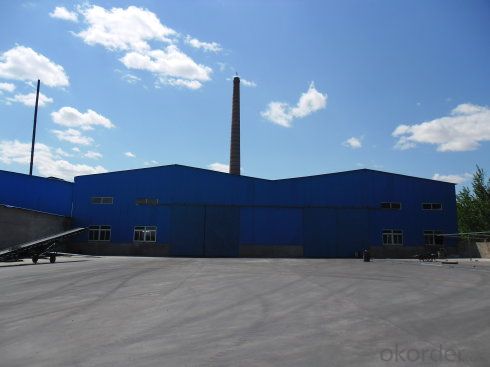
4. Calcined Petroleum Coke Specification
| Place of Origin: | Henan, China (Mainland) | Brand Name: | CNBM | Model Number: | YY-CPC-A |
| Application: | as fuel, electrodes | Dimensions: | 3-8cm | Chemical Composition: | F.C |
| Ash: | 0.8% | V.M: | 0.5% | water: | 0.3% |
| sulfur: | 0.8% | Size: | 3-8cm |
5.FAQ of Calcined Petroleum Coke
1). Q: Are you a factory or trading company?
A: We are a factory.
2). Q: Where is your factory located? How can I visit there?
A: Our factory is located in ShanXi, HeNan, China. You are warmly welcomed to visit us!
3). Q: How can I get some samples?
A: Please connect me for samples
4). Q: Can the price be cheaper?
A: Of course, you will be offered a good discount for big amount.
- Q: What are the effects of carbon emissions on the Earth's temperature?
- The Earth's temperature is significantly impacted by carbon emissions, particularly carbon dioxide (CO2), which is due to the greenhouse effect. The greenhouse effect is when certain gases in the Earth's atmosphere trap heat from the sun and prevent it from escaping into space, thus causing the planet to warm. When carbon emissions are released into the atmosphere, they act like a blanket, trapping more heat and making the greenhouse effect worse. This results in global temperatures increasing, commonly known as global warming. The main source of carbon emissions is the burning of fossil fuels such as coal, oil, and natural gas for energy production, transportation, and industrial processes. The accumulation of carbon dioxide and other greenhouse gases in the atmosphere has led to a steady rise in global temperatures over the past century. This temperature increase has various consequences for the Earth's climate system and ecosystems. One immediate impact of increased carbon emissions and global warming is the melting of polar ice caps and glaciers. As temperatures rise, ice melts at a faster rate, causing sea levels to rise. This poses a significant threat to coastal areas, with increased flooding and erosion potentially displacing communities and destroying habitats for different species. Moreover, global warming disrupts weather patterns, resulting in more frequent and severe extreme weather events. Heatwaves, droughts, hurricanes, and heavy rainfall become more common, causing damage to infrastructure, agriculture, and human health. Changes in precipitation patterns also affect water availability, potentially leading to water scarcity in certain regions. The Earth's temperature directly affects ecosystems and biodiversity. Many species are highly sensitive to even slight temperature changes, which can disrupt their natural habitats, alter migration patterns, and impact reproductive cycles. These changes can ultimately lead to the extinction of certain species and disrupt entire ecosystems. Furthermore, the warming of the Earth's temperature can have cascading effects on various natural processes. For example, it can cause the release of additional greenhouse gases from melting permafrost and the degradation of forests, further worsening global warming. In conclusion, the impact of carbon emissions on the Earth's temperature is significant and far-reaching. Global warming caused by increased carbon dioxide levels leads to the melting of ice caps, rising sea levels, extreme weather events, disruptions to ecosystems, and potential loss of biodiversity. Addressing carbon emissions and working towards sustainable practices are essential in mitigating these effects and ensuring a stable and livable planet for future generations.
- Q: What is carbon neutral certification?
- Carbon neutral certification is a process by which an organization, product, or service is evaluated and verified to have a net-zero carbon footprint. This means that the entity in question has taken significant measures to reduce its greenhouse gas emissions and has offset the remaining emissions through the purchase of carbon credits or investments in projects that mitigate or remove carbon dioxide from the atmosphere. To achieve carbon neutrality, the organization or product undergoes a rigorous assessment that includes measuring its carbon emissions, setting reduction targets, implementing initiatives to reduce its carbon footprint, and tracking progress. Once the emissions have been reduced as much as possible, any remaining emissions are offset by investing in verified projects such as reforestation, renewable energy, or energy efficiency projects that remove or reduce greenhouse gases from the atmosphere. The certification process is typically carried out by an independent third-party organization that evaluates and verifies the organization's carbon neutrality claims. This ensures transparency and credibility in the certification process. Once certified, the organization or product can use the carbon neutral label to demonstrate its commitment to environmental sustainability and responsible carbon management. Carbon neutral certification is important as it provides a standardized and recognized way for organizations and products to demonstrate their commitment to combating climate change. It allows consumers and stakeholders to make informed choices by supporting entities that have taken concrete steps to reduce their carbon emissions and contribute to a more sustainable future. Additionally, carbon neutral certification encourages organizations to adopt sustainable practices and invest in projects that have a positive environmental impact, thereby accelerating the transition to a low-carbon economy.
- Q: How does carbon impact the availability of natural resources?
- Carbon impacts the availability of natural resources by contributing to climate change. Excessive carbon emissions, primarily from burning fossil fuels, lead to global warming, which in turn affects the availability and distribution of resources such as water, food, and energy. Additionally, carbon pollution can cause ocean acidification, harming marine ecosystems and reducing fish populations. Therefore, controlling carbon emissions is crucial to ensure the sustainable availability of natural resources.
- Q: How does carbon impact the prevalence of tsunamis?
- Carbon dioxide does not directly impact the prevalence of tsunamis. Tsunamis are primarily caused by undersea earthquakes, volcanic eruptions, or underwater landslides. These events release massive amounts of energy into the water, generating powerful waves that can travel across the ocean and cause devastating destruction when they reach the coast. While carbon dioxide emissions do not directly cause tsunamis, they are linked to climate change, which can indirectly influence the occurrence and impact of these natural disasters. Increased levels of carbon dioxide and other greenhouse gases in the atmosphere contribute to global warming, resulting in rising sea levels. As sea levels rise, coastal areas become more vulnerable to the destructive power of tsunamis, as the waves can penetrate further inland. Furthermore, climate change can also affect the frequency and intensity of extreme weather events, such as hurricanes and tropical storms. These weather patterns can trigger underwater landslides or enhance the chances of volcanic eruptions, both of which can lead to tsunamis. In conclusion, while carbon dioxide emissions do not directly cause tsunamis, they play a role in the broader context of climate change, which can indirectly impact the prevalence and impact of tsunamis through rising sea levels and the potential for more frequent extreme weather events.
- Q: What are the consequences of increased carbon emissions on coastal regions?
- Increased carbon emissions have significant consequences on coastal regions. One of the most notable impacts is sea-level rise, caused by the warming of the planet and the subsequent melting of glaciers and ice sheets. This rise in sea levels can lead to coastal erosion, flooding, and the loss of coastal habitats. Additionally, carbon emissions contribute to ocean acidification, which harms marine life and coral reefs. The combination of these effects poses a threat to coastal communities, economies, and ecosystems, highlighting the urgent need for global action to reduce carbon emissions and mitigate the consequences.
- Q: How can I see if a battery can be used to recharge it?Can not all carbon batteries charge?
- Final conclusion:Carbon batteries, alkaline batteries are not charged, the voltage is 1.5V, nickel cadmium batteries, nickel hydrogen batteries can charge voltage 1.2VPay special attention to the risk of leakage or explosion if you charge to a carbon battery or alkaline battery
- Q: What does carbon nanotubes (5,5) in (5,5) mean?
- 3. get (5,5) after the initial point (0,0) to draw a line, this line is the circumference of the carbon nanotubes.
- Q: How do you use carbon fourteen to measure the age?
- One is obvious a small amount of sample, only 1 ~ 5 mg samples can be, such as a piece of fabric, bone chips, toner trace of ancient ceramics in the surface or pores can be measured; while the conventional carbon - 14 dating rules 1 to 5 grams of samples differ by 3 orders of magnitude. The two is high sensitivity. The sensitivity of 10-15 to 10-16 isotope ratio measurement; while the conventional carbon - 14 dating rules with a difference of 5 to 7 orders of magnitude. Three is a short measurement time, measurement of modern carbon to reach 1% accuracy, only 10 to 20 minutes; while the conventional carbon - 14 dating is 12 ~ 20 hours. It is due to carbon - 14 accelerator mass spectrometry dating method has the advantage, since its inception, has been paid attention to by archaeologists, paleontologists and geologists, and is widely used. It can be said that within 50000 years of cultural relics on the determination of samples, carbon - 14 accelerator mass spectrometry dating method is determined the accuracy of a maximum of 1. carbon. 14 is a radioactive isotope of carbon, was found in 1940. It is produced by cosmic rays collide with a nitrogen atom in the air, which has a half-life of about 5730 years, as the decay of beta decay, 14 atoms into carbon nitrogen atoms.
- Q: How is carbon used in the steel industry?
- The steel industry heavily relies on carbon as it plays a crucial role in the production and enhancement of steel. Carbon is added to iron in the fundamental process that transforms it into steel, resulting in the desired properties of hardness, strength, and durability. In steelmaking, carbon is primarily used as an alloying element to improve the mechanical properties of steel. The carbon content in steel can vary depending on the desired grade and application, ranging from 0.1% to 2%. Low carbon steel, with a carbon content below 0.3%, is commonly used for applications that require good formability and weldability. On the other hand, high carbon steel, with a carbon content above 0.6%, is used for applications that demand high strength and hardness. Carbon also plays a crucial role in the heat treatment process of steel. Through carburizing, steel undergoes a heating process with carbon-rich gases or solids to increase the carbon content at the surface. This results in a hardened surface layer with improved wear resistance, while maintaining a tough and ductile core. Additionally, carbon is essential in the use of electric arc furnaces (EAFs) in steelmaking. EAFs utilize electricity to melt scrap steel and other raw materials. Carbon is introduced during this process to reduce the oxides present in the raw materials, allowing for efficient steel production. In conclusion, carbon is widely utilized in the steel industry to achieve the desired properties of steel, enhance its mechanical properties through heat treatment, and enable efficient steel production. This versatile element enables steel to be used in a wide range of applications across various industries.
- Q: What is carbon offsetting in the hospitality industry?
- Carbon offsetting in the hospitality industry refers to the practice of counterbalancing the greenhouse gas emissions produced by hotels, resorts, and other hospitality businesses. It is a way to compensate for the carbon footprint created by various activities within the industry, such as energy consumption, transportation, waste management, and water usage. The process of carbon offsetting involves calculating the amount of carbon dioxide or other greenhouse gases emitted by a hospitality establishment and then investing in projects that reduce emissions elsewhere. These projects can include renewable energy initiatives, reforestation efforts, or energy efficiency programs. By supporting such projects, the hospitality industry aims to neutralize or offset its own carbon emissions, effectively reducing its impact on climate change. Hotels and resorts can choose to purchase carbon offsets from specialized organizations that facilitate carbon offset projects. These organizations ensure that the offsets are verified and comply with recognized standards, such as the Verified Carbon Standard or the Gold Standard. By investing in verified offsets, the hospitality industry can have confidence that their contributions are making a real and measurable difference in reducing global greenhouse gas emissions. Carbon offsetting in the hospitality industry is not only a way to demonstrate environmental responsibility, but it can also have economic benefits. Many travelers are becoming increasingly conscious of the environmental impact of their accommodation choices and are actively seeking out hotels and resorts that prioritize sustainability. By implementing carbon offsetting programs, hospitality businesses can attract environmentally conscious guests and differentiate themselves in a competitive market. Furthermore, carbon offsetting is just one part of a broader sustainability strategy within the hospitality industry. Many hotels and resorts are also adopting energy-efficient practices, implementing waste reduction measures, and promoting water conservation. By combining these efforts with carbon offsetting initiatives, the hospitality industry can contribute to a more sustainable future while also improving their bottom line. In summary, carbon offsetting in the hospitality industry involves investing in projects that reduce greenhouse gas emissions to compensate for the carbon footprint created by hotels and resorts. It is a way to neutralize the environmental impact of the industry and demonstrate a commitment to sustainability. By implementing carbon offsetting programs, the hospitality industry can attract environmentally conscious guests, differentiate themselves in the market, and contribute to a more sustainable future.
Send your message to us
Low Ash and Low Sulphur Calcined Petroleum Coke
- Loading Port:
- Tianjin
- Payment Terms:
- TT OR LC
- Min Order Qty:
- 1 m.t.
- Supply Capability:
- 10000000 m.t./month
OKorder Service Pledge
OKorder Financial Service
Similar products
Hot products
Hot Searches
Related keywords





